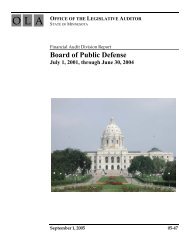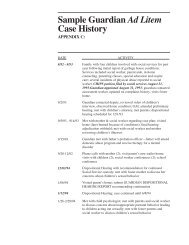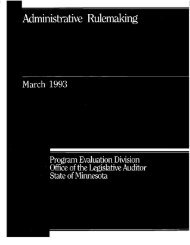Occupational Regulation - Office of the Legislative Auditor
Occupational Regulation - Office of the Legislative Auditor
Occupational Regulation - Office of the Legislative Auditor
Create successful ePaper yourself
Turn your PDF publications into a flip-book with our unique Google optimized e-Paper software.
50 OCCUPATIONAL REGULATION<br />
decisions that must be made by elected <strong>of</strong>ficials. And, we think <strong>the</strong> Legislature<br />
already has enacted into law good criteria for making those choices. The “key” is<br />
<strong>the</strong> Legislature’s willingness to apply those criteria more rigorously and<br />
consistently, both in deliberations on proposals for new or expanded regulation<br />
and in retrospective reviews <strong>of</strong> regulatory authority already enacted.<br />
MINNESOTA POLICY<br />
Minnesota’s occupational regulatory policy is set out in Minnesota Statutes<br />
Chapter 214, and elsewhere in statutes and rules. All proposals for new regulation<br />
are supposed to be evaluated against <strong>the</strong> criteria presented in Chapter 214. On <strong>the</strong><br />
basis <strong>of</strong> interviews and 13 case studies <strong>of</strong> recent proposals for regulation, we have<br />
concluded: 1<br />
· The state’s policy on occupational regulation articulated in Chapter<br />
214 is not applied consistently or effectively.<br />
Chapter 214 says that no regulation shall be imposed upon any occupation unless<br />
required for safety and well-being and lays out four criteria for regulation: 2<br />
Minnesota<br />
law outlines<br />
criteria for<br />
occupational<br />
regulation.<br />
· Whe<strong>the</strong>r <strong>the</strong> unregulated practice <strong>of</strong> an occupation may harm or endanger<br />
<strong>the</strong> health, safety, and welfare <strong>of</strong> citizens, and whe<strong>the</strong>r <strong>the</strong> potential for<br />
harm is recognizable and not remote.<br />
· Whe<strong>the</strong>r <strong>the</strong> practice <strong>of</strong> an occupation requires specialized skill or training<br />
and whe<strong>the</strong>r <strong>the</strong> public needs and will benefit by assurances <strong>of</strong> initial and<br />
continuing occupational ability;<br />
· Whe<strong>the</strong>r citizens are or may be effectively protected by o<strong>the</strong>r means; and<br />
· Whe<strong>the</strong>r <strong>the</strong> overall cost effectiveness and economic impact would be<br />
positive.<br />
If regulation is found to be necessary, <strong>the</strong> statutes require <strong>the</strong> least restrictive mode<br />
<strong>of</strong> regulation to be used. In ascending order, <strong>the</strong>se are:<br />
· Creation or extension <strong>of</strong> common law or statutory causes <strong>of</strong> civil action<br />
and <strong>the</strong> creation or extension <strong>of</strong> criminal prohibitions;<br />
· Imposition <strong>of</strong> inspection requirements and <strong>the</strong> ability to enforce violations<br />
by injunctive relief in <strong>the</strong> courts;<br />
· Implementation <strong>of</strong> a system <strong>of</strong> registration (defined in Minnesota as title<br />
protection);<br />
1 A brief description <strong>of</strong> <strong>the</strong> case studies is presented in Appendix B.<br />
2 Minn. Stat. §214.001








